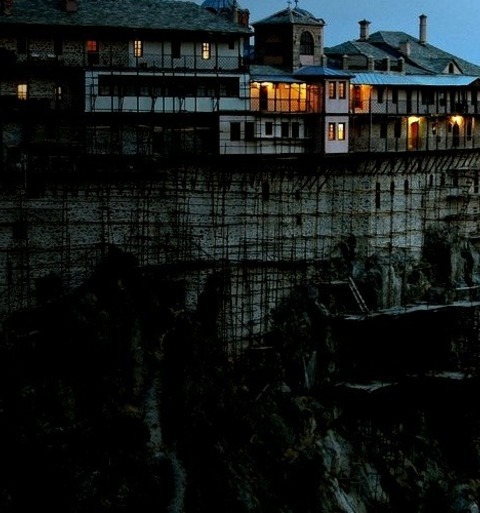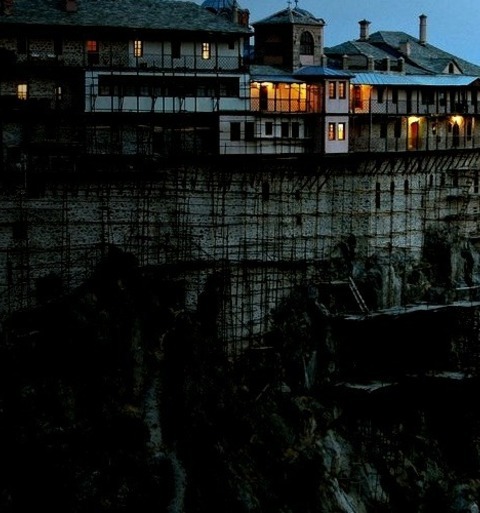#Simonopetra
Text

Travel poster for Mount Athos, featuring the Monastery of Simonos Petra (1949).
#vintage poster#vintage travel poster#greece#1940s#mount athos#Monastery of Simonos Petra#Simonopetra#travel#tourism#holiday#sea#monastery
156 notes
·
View notes
Text
"I am married" means that I cannot live a single day, even a few moments, without the companion of my life. My husband, my wife, is a part of my being, of my flesh, of my soul. He or she complements me. He or she is the thought of my mind. He or she is the reason for which my heart beats.
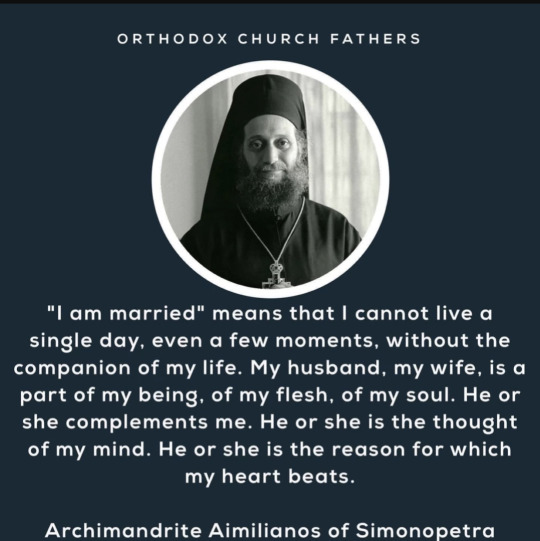
#orthodox#orthodox christianity#Archimandrite Aimilianos of Simonopetra#Orthodox marriage#marriage#the sacrament of marriage
16 notes
·
View notes
Video
youtube
#videos#Orthodox Christianity#Christianity#orthodoxy#Greek language#sermons#mystery#Holy Communion#Elder Aimilianos of Simonopetra#Orthodox Teachings of the Elders
0 notes
Text

Saint Simon le Myroblyte, Monastère de Simonopetra, XIII
805 notes
·
View notes
Photo
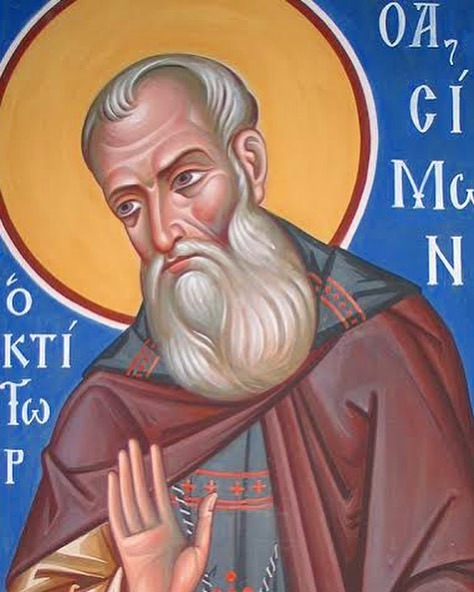
Today we also celebrate our Venerable Father Simon the Myrrh-Gusher of Simonopetra. Saint Simon lived an ascetical life on Mt Athos, and was glorified by many miracles. He was the founder of the New Bethlehem monastery, now known as Simonopetra. One night, he saw a star of such brightness that he thought it must be the Star of Bethlehem. Seeing the star remain motionless for several nights, he thought at first that it was a demonic temptation. On the eve of the Lord’s Nativity the star stood over a high rock, and Saint Simon heard a voice say, “Here, O Simon, you must lay the foundations of your monastery for the salvation of souls.” He built the monastery and called it New Bethlehem. He reposed in the year 1287, and his holy relics exude myrrh. May he intercede for us always + Source: https://www.oca.org/saints/lives/2007/12/28/103680-venerable-simon-the-myrrh-gusher-of-mount-athos (at Σιμωνόπετρα) https://www.instagram.com/p/CmsE-xIB9Q8/?igshid=NGJjMDIxMWI=
5 notes
·
View notes
Text
SAints&Reading: Sunday, December 31, 2023
december 18_december 31
SAINT MODESTOS, ARCHBISHOP OF JERUSALEM (4th c.)
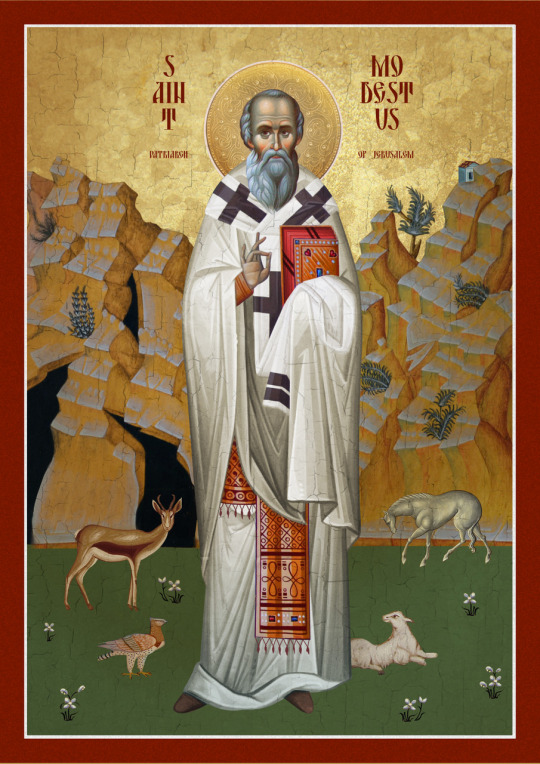
Saint Modestos (Módestos) was born into a Christian family at Sebásteia in Cappadocia (Asia Minor). Inclined toward a strict monastic life from his youth, the Saint was tonsured on Mount Sinai. Later, he became the Superior of the Monastery of Saint Theodosios the Great in Palestine. In the year 614, Syria and Palestine were attacked by the the army of the Persian king Chosroes. 90,000 Christians were killed, and many Christian churches were destroyed. Patriarch Zachariah of Jerusalem and a multitude of Christians were taken into captivity, along with the Cross of the Lord. Saint Modestos was appointed to govern the Jerusalem Church temporarily as locum tenens of the patriarchal kathedra.
With the help of Patriarch John the Merciful of Alexandria (November 12), Saint Modestos restored the devastated Christian shrines, among which was the Lord's Tomb. He also buried the murdered monks from the Monastery of Saint Savva the Sanctified. After fourteen years, Patriarch Zacharias returned from captivity with the Lord's Cross, and after his death, Saint Modestos became the Patriarch of Jerusalem. Saint Modestos reposed at the age of 97 in the year 634.
The head of Saint Modestós is located in the Athonite Monastery of Simonopetra.
Source: Orthodox Church in America_OCA
KNown also to be the protector of animals:
Once, there was a poor widow who had five pairs of oxen, which were her only means of support and which, unfortunately, they became very sick. The woman was deeply worried. She took refuge in the Church and entreated all Saints to help her in her time of need. Having not found any help, she called upon the Holy Unmercenaries Sts. Kosmas and Damian, to have mercy on her, a sinner, for she would lose her oxen because of her sins. Sts. Kosmas and Damian appeared in her sleep and told her that to them was not granted the grace to heal animals, for this Grace was granted by God to the great Bishop of Jerusalem Modesos, and if she went to him, her oxen would be healed. She awoke and hastened straightaway, seeking St. Modesos, but did not find him because he lived far from Jerusalem. She prayed with fervent faith for this Wonderworking physician to be revealed...
One night, the woman saw the Saint in a dream, who asked her why she was weeping, revealing to her that he was the Modestos that she was seeking and that he had heard her prayer and had come to heal her oxen! He advised her to cut off a portion of her iron tools, and to go to a place called "Lagenas", where there was a Church of the Archangel Michael. There, in front of the Church, lived a good artist named Eustathios, and with her iron, he would make a cross that she should bring to her home. In the morning, when the priests would be serving liturgy, she should take the cross, dip it in some oil, and immediately anoint her oxen in the name of Christ, and this supplication would heal them from their sickness.
The woman did as the Saint advised, and her oxen were healed, and she could resume her work without any problem, while all gave glory to God, Who gave such Wonderworking power to His servant Modestos. Since then, the art of the faithless and magicians could not affect the houses of faithful Christians, for they could not approach the wondrous power of that Cross. And even today, whoever celebrates the memory of Saint Modestos with faith, preparing a cross as mentioned above, his animals remain unharmed, through the Grace of our Lord Jesus Christ, from every diabolic energy and danger by men.
Source: the Myrrbearers St Martha and Mary Convent
St. GATIANUS , FIRST BISHOP OF TOURS (3rd c.)
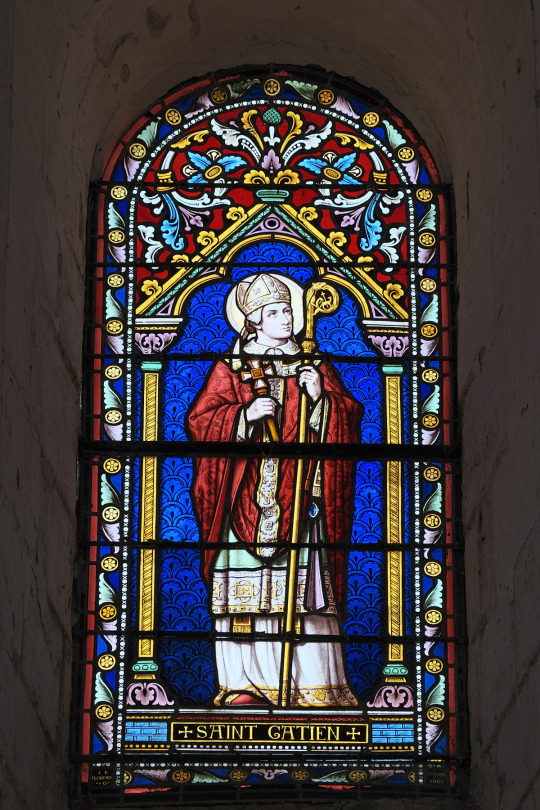
Pre-schism saint
St Gatianus was the founding bishop of the see of Tours. He was one of the "seven apostles of Gaul" commissioned by Pope Fabian to evangelize in the region.
According to Christian historians, during the consulship of the Emperor Decius and Vettius Gratus (250 AD), Pope Fabian sent out seven bishops from Rome to Gaul to preach the Gospel: Gatianus to Tours, Trophimus to Arles, Paul to Narbonne, Saturnin to Toulouse, Denis to Paris, Austromoine to Clermont, and Martial to Limoges. A community of Christians had already existed for many years in Lyon, where Irenaeus had been bishop.
As with other founders of the seven Catholic churches of Gaul, especially Martial, Gatianus became confounded in later western Christianity mythology with the "seventy-two disciples of Christ", alleged to have been sent into Gaul during the first century by Saint Peter himself, other details of his biography, while not as quickly disprovable, are also largely legendary. Gregory of Tours, writing in the 6th century, is a more dependable source for the few biographical details concerning his predecessor. According to the Catholic historian Mons. Louis Duchesne (Christian Worship: Its Origin and Evolution), the traditions preserved at Tours provided. Gregory with only the name of Gatianus and perhaps the 50-year extent of his episcopacy; it was by comparison with a brief early biography of Saturninus of Toulouse (Passio S. Saturnini) that Gregory arrived at the date 250 for the beginning of Gatianus' ministry at Tours (History of the Franks, 1.30).[3]
There were few Christians in Tours at that time. In one of the troubled years of his Episcopate, he is said for a time to have lain concealed in a cave on the banks of the Loire, at a spot where later rose the great Abbey of Marmoutier, and Gregory states that Gratianus would go into the city only when opportunities of preaching presented themselves. He devoted half a century to evangelization amid innumerable difficulties, and at his death, the diocese of Tours was securely established.
In a part of the Empire where Mithraism was a dominating force among the legions, the Abbé Jaud reports that Gatianus likewise retreated into a grotto and there celebrated a mystical banquet (célébrait les saints mystères). Gatianus was often portrayed officiating at a ceremony in a cavern-like setting. Two grottos cut into the limestone hill above the river Loire, across from Tours at the largely demolished Marmoutier Abbey, are designated the first sites where Gatianus celebrated the Divine Liturgy.
The abbey of Marmoutier, which sprung from the grottos in the cliff to which Saint Gatianus and Saint Martin retired to pray, was, therefore, the creation of the latter worthy. ..Gatianus established a hospice for the poor outside the walls of Tours. There he reposed, overcome with weariness, after five decades of fasting, penances, and toil. And there, the abbé Jaud relates, the Saviour appeared to him, saying, "Fear not! Thy crown is readied, and the Saints await thy arrival in Heaven."
After Gatianus' death, during renewed persecution of Christians, the see of Tours remained unoccupied for 36 years. The Christians were dispersed and any direct connection with the historical Gatianus was utterly broken. Gregory records the second bishop as Lidorius, traditionally credited with building the predecessor of the present cathedral in Tours, and states that he was bishop for 33 years until Saint Martin arrived in Tours in 371 AD. However, Martin found few Christians in this city; local lore nevertheless kept the legend of Gatianus alive. Martin found Gatianus' burial site, and always venerated his predecessor. With the rise in importance of Paris, Gatianus became seen more and more as a disciple of Saint Denis, and is so described at many modern Catholic websites.
Tours became a major pilgrimage site, focused on the tomb of Saint Martin of Tours. The cathedral, originally consecrated to Saint Maurice, was reconsecrated to Saint Gatianus at its 13th century rebuilding. His relics were destroyed in 1793, during the French Revolution. Petty ambitions and little tragedies of mid-19th century provincial life, centered on the cathedral, are portrayed in Honoré de Balzac's Le Curé de Tours ("The curate of Tours").
Source Wikipedia (edited for clarity)


HEBREWS 11:9-10, 17-23, 32-40
9 By faith he dwelt in the land of promise as in a foreign country, dwelling in tents with Isaac and Jacob, the heirs with him of the same promise; 10 for he waited for the city which has foundations, whose builder and maker is God. 17 By faith Abraham, when he was tested, offered up Isaac, and he who had received the promises offered up his only begotten son, 18 of whom it was said, "In Isaac your seed shall be called," 19 concluding that God was able to raise him up, even from the dead, from which he also received him in a figurative sense. 20 By faith Isaac blessed Jacob and Esau concerning things to come. 21 By faith Jacob, when he was dying, blessed each of the sons of Joseph, and worshiped, leaning on the top of his staff. 22 By faith Joseph, when he was dying, made mention of the departure of the children of Israel, and gave instructions concerning his bones. 23 By faith Moses, when he was born, was hidden three months by his parents, because they saw he was a beautiful child; and they were not afraid of the king's command. 32 And what more shall I say? For the time would fail me to tell of Gideon and Barak and Samson and Jephthah, also of David and Samuel and the prophets: 33 who through faith subdued kingdoms, worked righteousness, obtained promises, stopped the mouths of lions, 34 quenched the violence of fire, escaped the edge of the sword, out of weakness were made strong, became valiant in battle, turned to flight the armies of the aliens. 35 Women received their dead raised to life again. Others were tortured, not accepting deliverance, that they might obtain a better resurrection. 36 Still others had trial of mockings and scourgings, yes, and of chains and imprisonment. 37 They were stoned, they were sawn in two, were tempted, were slain with the sword. They wandered about in sheepskins and goatskins, being destitute, afflicted, tormented- 38 of whom the world was not worthy. They wandered in deserts and mountains, in dens and caves of the earth. 39 And all these, having obtained a good testimony through faith, did not receive the promise, 40 God having provided something better for us, that they should not be made perfect apart from us.
JOHN 20:11-18
11 But Mary stood outside by the tomb weeping, and as she wept she stooped down and looked into the tomb. 12 And she saw two angels in white sitting, one at the head and the other at the feet, where the body of Jesus had lain. 13 Then they said to her, "Woman, why are you weeping?" She said to them, "Because they have taken away my Lord, and I do not know where they have laid Him." 14 Now when she had said this, she turned around and saw Jesus standing there, and did not know that it was Jesus. 15 Jesus said to her, "Woman, why are you weeping? Whom are you seeking?" She, supposing Him to be the gardener, said to Him, "Sir, if You have carried Him away, tell me where You have laid Him, and I will take Him away." 16 Jesus said to her, "Mary!" She turned and said to Him, "Rabboni!" (which is to say, Teacher). 17 Jesus said to her, "Do not cling to Me, for I have not yet ascended to My Father; but go to My brethren and say to them, 'I am ascending to My Father and your Father, and to My God and your God.' " 18 Mary Magdalene came and told the disciples that she had seen the Lord, and that He had spoken these things to her.
#orthodoxy#orthodoxchristianity#easternorthodoxchurch#originofchristianity#spirituality#holyscriptures#gospel#bible#wisdom#saints
0 notes
Text

https://youtu.be/PB96ILxKmic
Σπάνιο ιστορικό βίντεο μέσα στο ποιο εντυπωσιακό μοναστήρι του Αγίου Όρους που παρουσιάζει τη ζωή των μοναχών την περίοδο των Χριστουγέννων.
Περισσότερα εδώ: https://romios.gr/agion-oros-christoygenna-sti-simonopetra-spanio-istoriko-vinteo-2/
0 notes
Photo

#travel#simonospetras #greece🇬🇷 #Monastery #traveldiary#simonospetra #traveling #travelgram #architecturephotography #bluesky (la Simonopetra) https://www.instagram.com/p/Cpf7wBGtpyY/?igshid=NGJjMDIxMWI=
#travel#simonospetras#greece🇬🇷#monastery#traveldiary#simonospetra#traveling#travelgram#architecturephotography#bluesky
1 note
·
View note
Text
Монастырь Симонопетра - один из 20-ти монастырей на Святой Горе Афон; занимает 13-е место в иерархии монастырей Афона. Монастырь Симонопетра назван в честь своего основоположника - прп. Симона. Он подвизался на Святой Горе в XIII веке в недоступном месте в маленькой пещере, которая сохранилась и поныне.
Подробнее о монастыре: https://athos.life/monastyri/simonopetra
Подписаться на Telegram канал: https://t.me/athos_life
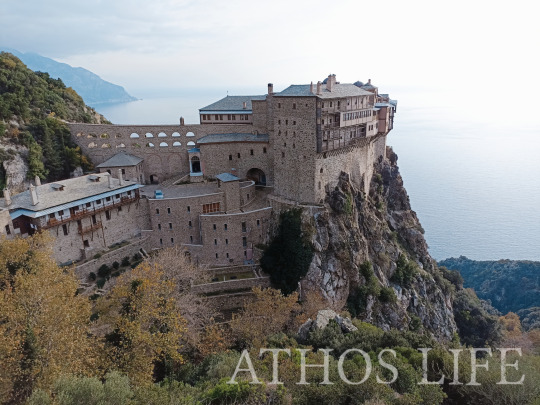
0 notes
Text
“Spiritual health is not found in the avoidance of suffering, but in its joyful acceptance”

Psalm 87:17 LXX (88:16) “The outbursts of Your wrath have swept over me, and Your terrors have greatly troubled me”
With these words, the psalmist is expressing the thoughts of every soul that suffers. More precisely, he is describing the experience of suffering undergone by the soul. And this experience consists essentially of a conflict, for this is the moment when the soul is passing, as it were, through the “Clashing Rocks” of ancient mythology, known as the Symplegades. In this dangerous passage, the soul has to make a choice, and the outcome will either break it into pieces or enable it to sail to its destination in God. And the choice comes down to this: will the soul accept or reject suffering? Will it make this suffering its own, or struggle against it, seeing it as something alien to itself? To be sure, God exists. But the psalmist is overwhelmed by his suffering, and this is the cause of the whole drama. And so he has to make a choice. If he chooses to accept his suffering, he must embrace it within the wholeness of his life; he must discover and accept the proper relation to his suffering. If he can do this, he will have transformed his suffering so that in the end his only reality will be God. But if he continues to resist his suffering, refusing to find his salvation in it, his anguish will continue unabated. The question is ultimately this: Will he offer himself as a voluntary sacrifice to the will of God, or not?
Consistent with the witness of Scripture – which is so much more powerful and theologically accurate than the modern idea that God has no real relation to the world – the psalmist believes that God is acting tyrannically toward him. In the face of such a situation, what must the psalmist do? He must accept as his own will, as his own desire, the will of God for his life. If this happens, he will cease being anxious about his sufferings, for he will see that they too are the signs and tokens of God’s presence.
It follows from this that the psalmist’s salvation hinges on a single decision, namely, the acceptance or rejection of his suffering. To the extent that he struggles against his suffering, seeking to disown and reject it, his agony will only intensify. The avoidance of suffering serves only to increase suffering in a vicious cycle that never ends. If, on the other hand, he chooses to entrust himself to God, and so recognize in his suffering God’s mercy and love; if he is able to see his suffering as the proof of God’s love for him, then he will undergo another, greater experience that will shake him to the core of his being. Just when he thinks that his life is about to end, that he is about to breathe his last, he will feel, not simply an upward surge into new life, but deep within himself the presence of the long-lived seed mentioned by the Prophet Isaiah: It was the will of the Lord to bruise him; He has put him to grief; yet when he makes himself an offering for sin, he shall see his offspring, a long-lived seed, and the will of the Lord shall prosper in his hand; he shall see the fruit of his suffering of his soul and be satisfied (Is 53:10). Spiritual health is not found in the avoidance of suffering, but in its joyful acceptance. The psalmist’s dilemma lies precisely in whether or not he will accept his sufferings or reject them, which is another way of saying that the choice he needs to make is whether to accept or deny God.
– Archimandrite Aimilianos of Simonopetra, Psalms and the Life of Faith, pp. 100-102
0 notes
Text
Monastery of Simonos Petras Mount Athos Greece
Monastery of Simonos Petras Mount Athos Greece
The seven-stored monastery of Simonopetra is the most bold construction of the peninsula, and is dedicated to the birth of Christ. The name comes from the founder of the monastery, Hosios Simon, who lived in Athos in the mid 14th c.The Katholicon was built after the last fire and has no frescoes. The monastery has 15 chapels and 5 Kellia in Karyes.
At the end of 16th c. the monastery is burnt…

View On WordPress
0 notes


